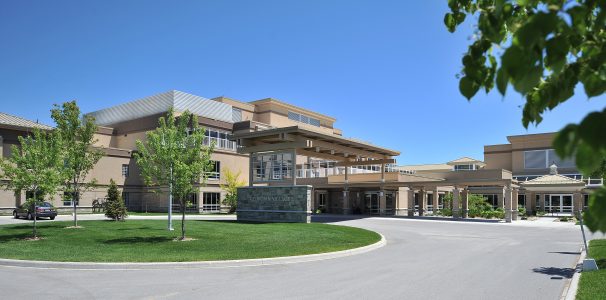Other
The County of Simcoe, Regional Municipal Government
- Local authorities
- Older People’s Association
- Social or health care provider
- Volunteers
- Private sector
Collaboration with many business partners, including internal and external stakeholders, was instrumental in achieving the expansive latitude of housing and programs included as part of this continuum as well as in securing crucial resources to ensure the financial viability of this project. The County forged significant relationships with government, public and private agencies, community interest groups, clients, media, and local residents in bringing this vision to life.
Federally, the County partnered with the Government of Canada, New Horizon funding to create a sustainable intergenerational gardening program. This seed money led to the development of a community “greenhouse” on the new campus. With increased public interest and awareness of the needs of this vulnerable population, also grew an increased disposition to provide support for local development by contributing to a community fundraising campaign.
Provincially, the County received capital funding from the Ministry of Municipal Affairs and Housing directed through a federal/provincial capital funding program to support the creation of 40 new affordable housing units. Our existing 107-bed long-term care home received capital funding from the Ministry of Health and Long-Term Care to support the redevelopment of the home into a beautiful and more functional Class A facility. These partnerships were further augmented with tremendous support from the North Simcoe Muskoka Local Health Integration Network (NSMLHIN) who approved and funded an additional 36 long-term care beds and a new level of service in the provision of convalescent care. During the planning phase, the NSM LHIN co-hosted partnership forums with the County that fostered a number of onsite collaborations that included the: co-location of the Victorian Order of Nurses and on-site programming; the delivery of meals on wheels in partnership with the Canadian Red Cross; the provision of equipment and campus-wide access to the OTN with a broader community outreach component; and an enhanced partnership with Georgian College that led to the establishment of a new satellite part-time Practical Nurse program hosted at Georgian Village. In addition, the NSM LHIN provided one-time funding for the purchase of a 16-passenger accessible van and several small multi-passenger shuttles.
As a regional level of government, capitalizing on the strengths of our internal support departments provided significant fortitude in such areas as housing, Information Technology (IT), Finance, Procurement, Fleet and Property, Communications, Planning, Roads, Forestry and By-law, Library, Emergency Management, Paramedicine, and Long-Term Care and Seniors Services.
The last, but certainly not least of our government relations focused on our local municipal partner; the Town of Penetanguishene. Working together throughout the project, the Town provided a spectrum of support that ranged from such things as signage approvals, building permits and inspections, to the waiving of development charge fees, connecting local pedestrian, bus routes and municipal trail systems.
Georgian Village also raised funding as part of the overall project as a result of the generosity of our local residents and many partnered agencies. In addition to all levels of government, the County fostered many other partnerships in achieving an entire continuum of services. Working with our attending and local physicians, a Family Health Team was established on site by a lead physician as a significant component of this model. Initially operating with two (2) physicians and a nurse practitioner, the Village Clinic offers improved access to primary care, lends itself to house calls when needed, utilizes OTN to access other health-care specialists, and has the capacity to double their services in future.
The expansive list of services outlined within the Community Hub, is a direct consequence of strengthening existing and forging new partnerships to improve access through a “one-stop shopping” concept. Having access to a host of paramedical supports and essential services such as lab, ensures seniors have timely and accessible care to maintain their optimal level of health. Further, a natural extension of this environment has been the provision of Health and Wellness Clinics that facilitate client education focused on health promotion in such key areas as chronic disease management, nutritional care, healthy living, exercise, and medication management. Other areas of focus include nursing and paramedic student placements in partnership with local community colleges and training facilities.
Currently, Georgian Village Senior Campus continues to foster several collaborative service arrangements which include VON SMART program, Red Cross Home Support Services, Seating and Mobility Clinics, Ontario Telemedicine program, Georgian College collaboration for education and placement of students, Penetanguishene Library, County of Simcoe Regional Library Cooperative, Georgian Village Hair Salon, Audia Hearing Centre, Community Living Huronia, Wendat, Rosewood, Georgian Bay General Hospital, North Simcoe Muskoka LHIN, local physicians, pharmacies, Town of Penetanguishene, NSM Behavioral Support Services, Waypoint Mental Health, Alzheimers Society, NSM Palliative Care Network, Hospice Huronia, Lifelab, Achieva Health, Religious Services, Bayshore HomeHealth for Nursing, Paramed for PSW, Penetanguishene Seniors Council, First Nations, Metis Nations.
In summary, involving a broad spectrum of collaborators in the business plan generates financial and operational support, builds capacity, enhances communications, expands service options, and lends significant credibility to the overall concept.
Older people were involved in the age-friendly practice at multiple or all stages
A wide range of activities were conducted that included client surveys, focus groups, informant interviews, public and government consultations, environmental scans, review of local socio-economic factors, growth considerations, and contracting professional expertise to complete a formal market study. This was further augmented with the creation of a project steering committee comprised of more than 30 internal and external stakeholders that assisted to inform decision making and ensure ongoing


